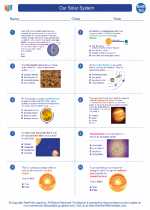Saturn
Saturn is the sixth planet from the Sun and the second-largest in the Solar System, after Jupiter. It is a gas giant with an average radius about nine times that of Earth. Here's a detailed study guide to help you understand more about Saturn:
Overview of Saturn
Saturn is known for its beautiful rings, which are made up of ice, rock, and dust particles. It is mostly composed of hydrogen and helium. Saturn has the fastest rotation period of any planet in the Solar System, completing a rotation in about 10.8 hours.
Physical Characteristics
- Radius: 58,232 km
- Mass: 5.68 × 10^26 kg
- Surface temperature: -178 degrees Celsius
- Atmosphere: Mostly hydrogen and helium
Rings of Saturn
Saturn's rings are made up of countless small particles, ranging in size from micrometers to meters. The rings are divided into several main groups and are named alphabetically in the order they were discovered. The main rings are A, B, and C, with the Cassini Division separating rings A and B.
Exploration
Saturn has been visited by several spacecraft, including the Pioneer and Voyager missions. The Cassini-Huygens mission, which arrived at Saturn in 2004, provided detailed information about the planet and its moons. It also discovered geysers on Saturn's moon Enceladus, suggesting the presence of a subsurface ocean.
Moons of Saturn
Saturn has at least 82 moons, with the largest being Titan, which is larger than the planet Mercury. Titan has a thick atmosphere and is the only moon in the Solar System with a significant atmosphere. Enceladus, another moon of Saturn, has geysers that eject water vapor and ice particles into space.
Conclusion
Saturn is a fascinating planet with its iconic rings and diverse moons. Studying Saturn provides valuable insights into the formation and evolution of the Solar System.
.◂Earth Science Worksheets and Study Guides High School. Our Solar System

 Worksheet/Answer key
Worksheet/Answer key
 Worksheet/Answer key
Worksheet/Answer key
 Vocabulary/Answer key
Vocabulary/Answer key
 Vocabulary/Answer key
Vocabulary/Answer key
 Vocabulary/Answer key
Vocabulary/Answer key
